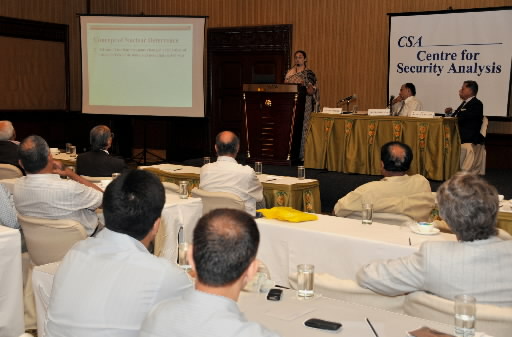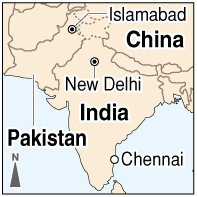Nuclear weapons can be eliminated: Chapter 2, Part 7
Apr. 24, 2009
Chapter 2: South Asia’s cold war
Part 7: Path to dismantling of nuclear arsenals
by Junichiro Hayashi, Staff Writer
Dialogue between all nuclear nations needed
In late February, as the city of Chennai in southern India sweltered in 30-degree temperatures (°C), a heated debate went on at a symposium on nuclear disarmament being held at a local hotel.
Sponsored by the Centre for Security Analysis, the symposium was attended by about 40 military leaders and researchers. Following his speech, V. R. Raghavan, 73, the centre’s president, patiently answered questions from the audience. “If the number of nuclear weapons is reduced, it will be more difficult for terrorists to obtain them,” he said. “So, we must eliminate them entirely.”
Mr. Raghavan was in the Indian Army for 37 years until retiring in 1994 after serving as Director General of Military Operations. He now serves on the advisory board for the International Commission on Nuclear Non-proliferation and Disarmament, a joint initiative of the Australian and Japanese governments, which has fostered debate on nuclear issues.
After his lecture, I asked Mr. Raghavan how nuclear weapons could be eliminated.
“Creating an international treaty by which countries agree not to use nuclear weapons would make it possible to eliminate them,” he said, “but whether or not P5 takes action is the key.”
P5 refers to the permanent members of the United Nations Security Council: the U.S., Russia, China, the U.K. and France. These are also the five nuclear nations as set forth under the terms of the Nuclear Non-proliferation Treaty. The progress on nuclear disarmament that has been made thus far has been the result of cuts by these five nations to their own arsenals and negotiations between the U.S. and Russia.
Neither India nor Pakistan is a party to the NPT, however, and they seldom have opportunities to meet with P5 nations. For this reason, Raghavan said he feels it is necessary to create an opportunity for all of the nuclear nations to sit down to talks together.
In Pakistan as well, few people suggest that the nation should take the lead and cut its own nuclear arsenal. At the Institute of Strategy Studies, Islamabad, Fazal Rahman, 48, said, “Nothing will happen on nuclear abolition unless the U.S. takes action. And as long as China has nuclear weapons, India won’t give them up.”
Most of the other experts I met in India and Pakistan said that before nuclear weapons can be abolished, steps must be taken to prevent their use and development. Improving relations with neighboring nations is a basic premise. If no progress is made in this area soon, in order to achieve nuclear disarmament and non-proliferation both countries must place top priority on efforts to effectuate the Comprehensive Test Ban Treaty (CTBT), which neither nation has signed.
Other nations besides the P5 acquired nuclear weapons in the latter half of the 20th Century, just as India and Pakistan did. The situation in the two nations demonstrates how difficult it is for a country to give up nuclear weapons once it has acquired them. The goal of nuclear abolition can be reached down the difficult paths to global dialogue on nuclear disarmament and the building of mutual trust between regions.
(Originally published on March 27, 2009)
To comment on this article, please click the link below. Comments will be moderated and posted in a timely fashion. Comments may also appear in the Chugoku Shimbun newspaper.









